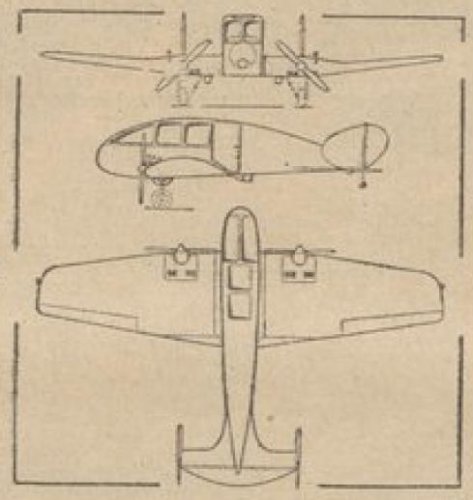For our non-French speaking members, here's a rough translation of the article from Les Ailes:
A SMALL CANADIAN AIRCRAFT Two Canadian engineers, A. Craigon, of Toronto, and Mac Donald, the latter of "Aviation Service Corporation Ltd. », Undertook the realization of a light twin-engine which presents original characteristics. The device is intended to carry out small transport across the country and its use for the training of military pilots is also envisaged. The manufacturers propose to sell it at a very low price.
The shape of the fuselage is in wing profile, the NACA 6241; it is not absolutely new, because Burnelli, de Monge and Carmier, among others, have already experienced it for a long time. But this shape given to the fuselage complements those given to the wing. This in fact comprises a thick central portion, also provided with the NACA 6241 profile, inside which the motors are housed; this central part is extended, on each side, by half wings whose profile changes from 6241 to NACA 2409. The results recorded in the aerodynamic tunnel, with a model, would have confirmed the qualities of this wing which would, in particular, have good lift at low speeds and a suitable angle of glide. The wings are provided with triangular high lift flaps which can be used for takeoff and landing.
The cooling of the engines is ensured by an air circulation channeled by conduits formed in the leading edge of the wing. The tests will be carried out with two Continental A50, of 50 CV. each, which will drive variable diameter propellers, propellers designed by A. Craigon and whose diameter would be 1 m. 78, for takeoff and landing, and 1 m. 98 for horizontal flight. Unfortunately, there is no information on the mechanism of these curious propellants. The engineer Craigon also created a hydromechanical starter enabling the engines to be started from inside the fuselage, by pressing a pedal. Craigon, finally, would have also studied a small diesel engine, heavy oil, developing 50 CV., Which he proposes to mount thereafter on his devices. Let us add that the landing gear, retractable, is raised under the action of a mechanical hand control.
The general characteristics of the aircraft are as follows: wingspan, 10 m. 37; length ,7 m. 50; load-bearing surface, 18 mq. 40; empty weight, 482 kg .; chargeable charge (two passengers and their luggage), 201 kg; total mobile load, 378 kg. weight in flight order, 860 kg - With two 50 hp engines, the theoretical performance can be summarized as follows: maximum speed, at 1,900 rpm, 225 km.-h .; cruising speed, at 100 rpm, 200 km / h .; ascending speed, 380 m./min .; landing speed, 60/65 km.-h .; practical ceiling. 5.490 m .; normal range, 1,100 km.

